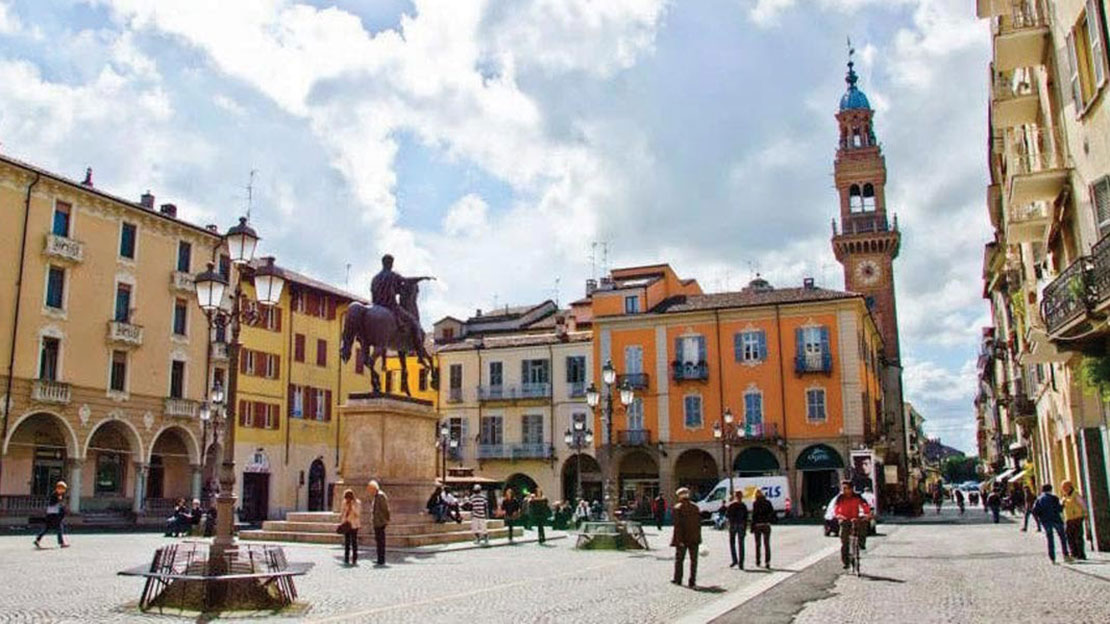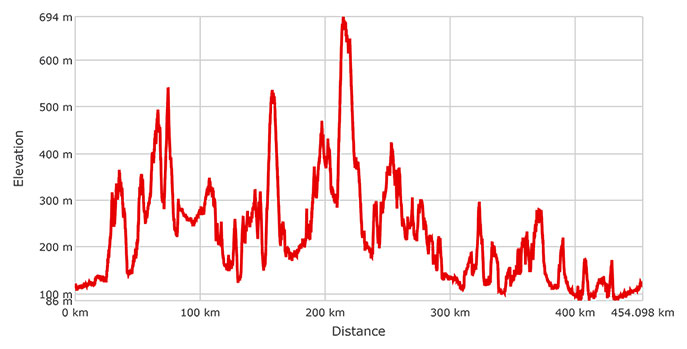
- Bike: strada/trekking
- Difficulty: *****
- Distance: 454 km
- Altitude difference: 608 m
- Total ascent: 6769 m
- Total descent: 6770 m

FIAB Monferrato Bike came up with this cycle route through Monferrato, which evokes the legendary ride taken by Aleramo, forefather of the Aleramici dynasty of Monferrato. Every year, from April to October, you can take part in the randonnée del Monferrato Aleramico. It's free to sign up and open to all comers. The route is 454 km long and involves a total climb of 6,769 m. It's certainly quite a challenge, but anyone can manage it if they make enough stops, as long as they finish within the 214 days set out in the rules. To win the title of 'Aleramici cycling knight of Monferrato', and the personal parchment that comes with it, you need a travel pass, which is just a form you can get online, with all 18 of the stamps from the official rando points (checkpoints run by cafés or the municipal council), along with the two for starting and finishing. You'll find these rando points roughly every 25 km along the route, the minimum distance for every section. Some cyclists choose just to do one section, some a selection. Some people organise a whole holiday around it and some maniacs try and do the whole Aleramo challenge in just three days.
Information for signing up (April to October): www.fiabmonferrato.com.
Aleramo was born in 904 at the abbey of Santa Giustina in Sezzadio, and orphaned at an early age when his parents, of noble German stock, died on pilgrimage in Italy. Although the family who adopted him were also noble, he decided to take on humble work as a kitchen boy for the bishop of Albenga.
It was in 966 that Otto I, king of Italy for 15 years already and recently crowned Holy Roman Emperor to boot, found himself ranged with his army and allies, among them the bishop of Albenga, against southern subjects of his who had rebelled in the siege of Brescia. Despite the defensive skills of the German soldiers, a group of rebels managed to get into the emperor's tent and threaten his life. Just when all seemed lost, a mysterious knight unleashed a vicious attack and forced the Brescia rebels to beat a retreat. Emperor Otto I was bowled over, and wanted to know who the valiant soldier was who had saved his life.
The bishop of Albenga revealed him to be none other than Aleramo, a lowly kitchen boy, nicknamed 'Carbonaio' ('coalman'). So it was that the emperor made Aleramo one of his knights and entrusted him with bringing up his daughter, Alasia. Love blossomed between the two youths. But the emperor was having none of it, and so the lovers fled to Alassio.
Aleramo was later pardoned by Otto I, who made him both a marquess and a proposal: the emperor offered him power over as many regions as he could ride over without stopping.
As legend has it, Aleramo rode for three days and nights, managing to cover more than 400 km and kill three horses in the process. He rode from the river Po to the Ligurian coast, thus defining the borders of Monferrato.
They say even the region's name comes from Aleramo's famous ride; the marquess used a brick ('mattone') to shoe ('ferrare') his horse, hence 'Monferrato'. Aleramo probably died before 991 and, according to tradition, was buried in the abbey of Grazzano (now Grazzano Badoglio), of his own founding.
We will sum up the route.
It begins in Casale Monferrato, at the Paleologi castle in Piazza Castello, and the first stop is Trino. Go through the scenic country around Gabiano to the second stop, Robella d’Asti. The next 25 km is a series of short ascents on quiet little roads.
The climb to Albugnano (491 m into the route), is not such a cakewalk, but you can stop in the village and visit the nearby canon house of Santa Maria in Vezzolano.
After this, the hills get gentler, until the fifth stop, Valfenera. The route is easy going between here and the next stops in San Martino Alfieri and Canelli. After these villages, famous for still and sparkling wine respectively, there's a slightly more tricky stretch in store. Your next stop is Monastero Bormida, followed by an uphill road to Loazzolo (535 m). Follow the Bormida valley to Spigno Monferrato, after which the climb is steeper. Pareto is you next stop, in the foothills of the Piedmontese-Ligurian Apennines. 208 km into the route, at 305 m above sea level, begins the climb to the highest point on Aleramo's ride, at Cimaferle di Ponzone (694 m). The view over the Apennines from here is spectacular. This is followed by a long descent to the tenth stop on the route, Cassinelle. Keep going gently downhill until the town Ovada, where you'll find a rando point (and where it's worth stopping to try some chickpea farinata). Go uphill again towards Bosio, the municipality in which the Capanne di Marcarolo natural park lies, then through Gavi to Mornese, a village surrounded by vineyards and another stop on the route. Serravalle Scrivia is home to the second rando point, while in neighbouring Novi Ligure it's worth stopping to get a stamp at Museo dei Campionissimi, a museum dedicated to cycling champions Fausto Coppi and Costante Girardengo (this is an optional rando point, as the museum is only certain to be open at the weekend). Carry on along minor roads that are easy to cycle along to Predosa, deep in the Orba valley, where you can stop for another stamp. Some ups and downs over the hills of Asti will bring you to Mombaruzzo, home to a rando point. Leave this village, famed for its amaretto, and make your next stop in Refrancore, known for its finocchini, biscuits made from pastry containing fennel seeds. Carry on into the countryside of Monferrato Casalese. Pass the rando point at Lu Monferrato and the villages of Fubine Monferrato and Cuccaro Monferrato. Cross a few other villages, set down almost in a ring around Alessandria: Quargnento, Castelletto Monferrato, San Salvatore, Valle San Bartolomeo and finally Pietra Marazzi, on the river Tanaro. The route carries on along the Po from Bassignana to Valenza, which has a rando point. It ends by passing the hill of Monte Valenza, then going over the flat country around the Po, through Pomaro Monferrato, Bozzole, Valmacca, Ticineto, Frassineto Po and Casale Monferrato, where you can get the last stamp on the randonnée del Monferrato Aleramico.
